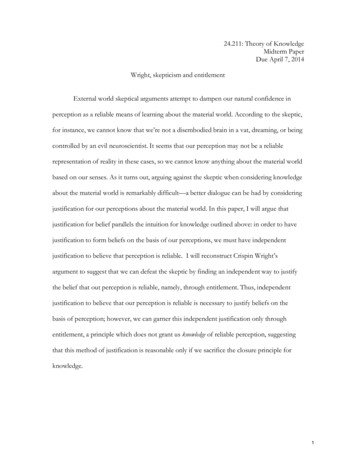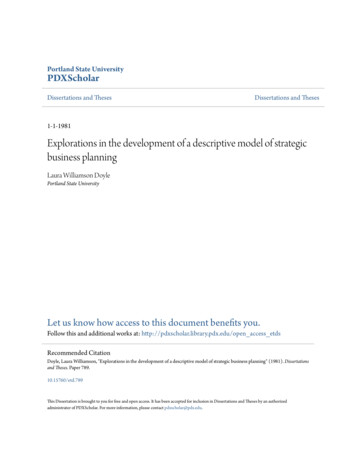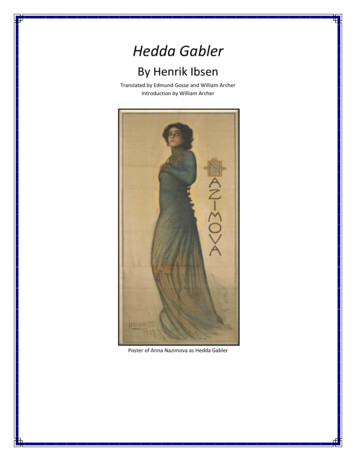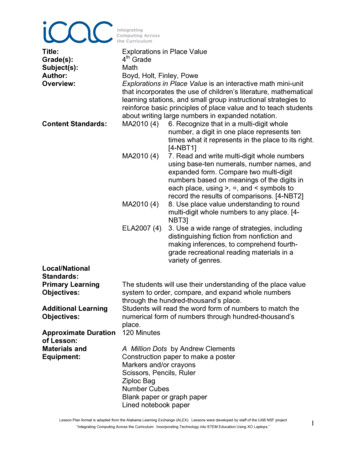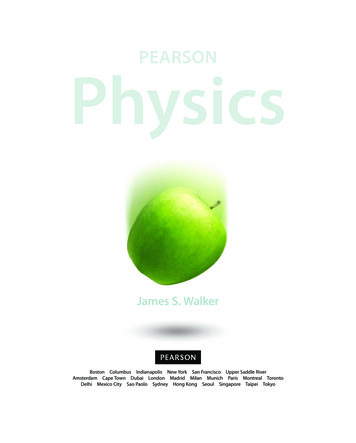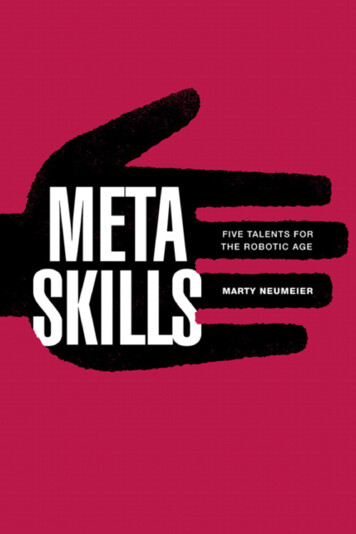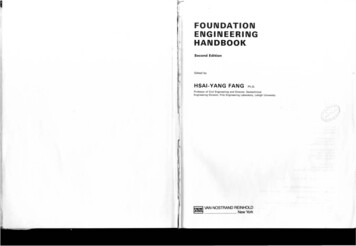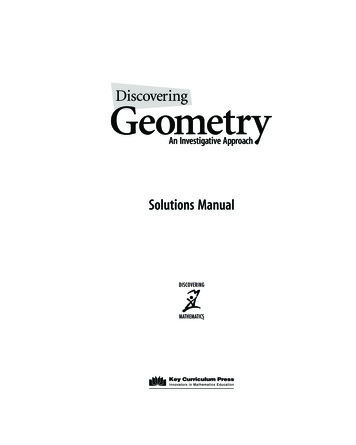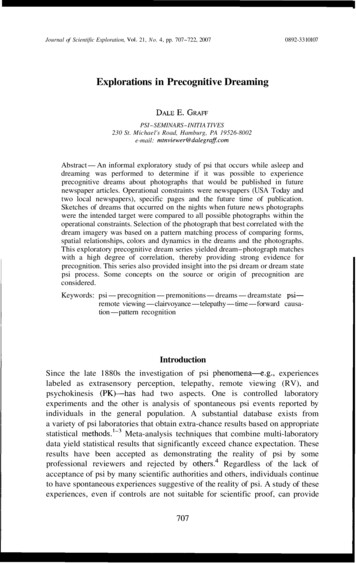
Transcription
Journal of Scientific Exploration, Vol. 21, No. 4, pp. 707-722, 20070892-3310107Explorations in Precognitive DreamingPSI-SEMINARS-INITIA TIVES230 St. Michael's Road, Hamburg, PA 19526-8002e-mail: mtnviewer@dalegraff comAbstract-An informal exploratory study of psi that occurs while asleep anddreaming was performed to determine if it was possible to experienceprecognitive dreams about photographs that would be published in futurenewspaper articles. Operational constraints were newspapers (USA Today andtwo local newspapers), specific pages and the future time of publication.Sketches of dreams that occurred on the nights when future news photographswere the intended target were compared to all possible photographs within theoperational constraints. Selection of the photograph that best correlated with thedream imagery was based on a pattern matching process of comparing forms,spatial relationships, colors and dynamics in the dreams and the photographs.This exploratory precognitive dream series yielded dream-photograph matcheswith a high degree of correlation, thereby providing strong evidence forprecognition. This series also provided insight into the psi dream or dream statepsi process. Some concepts on the source or origin of precognition areconsidered.Keywords: psi-precognition-premonitions-dreams-dream state psiremote viewing-clairvoyance-telepathy-time-forward causation-pattern recognitionIntroductionSince the late 1880s the investigation of psi phenomena-e.g., experienceslabeled as extrasensory perception, telepathy, remote viewing (RV), andpsychokinesis (PK)-hashad two aspects. One is controlled laboratoryexperiments and the other is analysis of spontaneous psi events reported byindividuals in the general population. A substantial database exists froma variety of psi laboratories that obtain extra-chance results based on appropriatestatistical methods.'-' Meta-analysis techniques that combine multi-laboratorydata yield statistical results that significantly exceed chance expectation. Theseresults have been accepted as demonstrating the reality of psi by someprofessional reviewers and rejected by others4 Regardless of the lack ofacceptance of psi by many scientific authorities and others, individuals continueto have spontaneous experiences suggestive of the reality of psi. A study of theseexperiences, even if controls are not suitable for scientific proof, can provide
708D. E. Graffinsight about the psi process and assist in developing procedures that canenhance experimentalSpontaneous cases occur in natural real-life circumstances and therefore aremore realistic than laboratory situations. Achieving psi data with improvedaccuracy and reliability would permit the scientific proof issue to be more easilyresolved and would also benefit those who seek to apply psi in various types ofsituations, such as assistance in police cases, for medical diagnostics or determining, via precognition emerging potential futures that pose a threat, such asterrorist plans.Insight into the psi process can also be achieved using a third method for psiinvestigation that is between life and laboratory.718It is neither under strictlaboratory control nor is it a mere anecdotal story. Since psi is an individualexperience, this third way of studying psi phenomena can be pursued by peoplein their comfortable home environment without the logistics and cost for travel,extensive coordination and involvement of others that laboratory researchrequires. Such field studies have the potential for identifying functionalparameters of psi and contribute to the accumulating psi database. I have foundthat it is useful to keep track of the mental state, awake and conscious orconscious state psi (CSP), and asleep and dreaming, or dream state psi (DSP),when examining psi data.Exploratory Psi Dream InvestigationsWe all experience dreams every night even if they are not recalled. Theeasiest dreams to recall when we desire to recall them are those that occur duringthe rapid eye movement phase of sleep, which occurs in about 25% of our sleeptime.9 In the mid-1970s, when I read the psi research by Ullman, Krippner andVaughn published in Dream e l e a t hI and, ' several others replicated theirbasic procedure and experienced clear evidence of psi or telepathic dreaming.Our informal experiments also revealed that dreaming could provide precognitive information about near-term future incidents.In early 2006, I became interested in the nature of time. I thought thataccumulating a systematic personal precognitive dream database should beinteresting and would provide insight into time and the psi dream process. It wouldalso improve my own understanding of psi. I have had occasional spontaneousprecognitive dreams, but they were too infrequent for systematic study.In order to explore precognitive dreaming as an independent psi investigator, Ihad to identify an objective that was realistic and that would yield results easilyevaluated from the later-learned ground truth.Future News Photographs as a Precognitive Dreaming ObjectivePrecognitive dreaming about future newspaper articles seemed to be aconvenient psi project to facilitate. All that was necessary was to establisha realistic future time frame, specify operational constraints, identify reasonable
Precognitive Dreaming709evaluation procedures and assure that appropriate documentation was maintained. It was also necessary to clearly specify the type of precognitive datasought. The early RV research at Stanford Research Institute International andmy own independent psi1RV projects clearly illustrated the dichotomy betweenRV seeing and knowing what is seen." An RVer can accurately sketch thedistant or otherwise shielded target area or picture but can usually not identify orname what it actually is. Therefore, in addition to maintaining a narrative of thesuspected precognitive dream, which requires naming imagery in the dreamcontent, I considered it essential to also sketch the dream's key elements,especially those at the end of the dream. I had discovered from psi dreams usingexisting targets that the dream's conclusion often presented the best imagery ofthe target picture.12 The ending was also easier to recall than other portions ofthe dream. The dream's ending is like a play: the play's most important message,its punch line, is presented as the finale. The most reasonable way to determineif a suspected precognitive dream was a valid precognition is to directly comparethe sketch or sketches of the dream's major elements or its ending to thepotential future newspaper photographs.I have also discovered that when the target picture is complex with several dominant features, several suspected psi dreams occur on the same night.Superimposing the dream's central images or their endings into one sketch canprovide a good representation of the target picture and the spatial relationshipsof its various fonns.13 When the target picture has only one main element, onlyone dream with one central image occurs. Psi dreams are characterized by theirbrevity and lack of personal material or day residue. Psilprecognitive dreams canbe experienced by setting a firm intention to experience and recall them, and tonot recall any other type of dream that night.14Remote viewing research and psi data in general have shown that psiperception of words, alphabets or numbers is not reliable. Therefore, for theseexploratory precognitive dreaming investigations, evaluation would be basedonly on visual comparisons between sketches of the dreams content and theimagery in the photographs in the future news articles, and not on any of itswritten material. However, remote viewing data correlated to the target objectiveof describing distant scenes, the expectation of the experimenters and possiblythe background of most of the remote viewers. The general observation of lowreliability for words and numbers is not necessarily representative for otherindividuals who experience psi and who may function better in other cognitivestyles than is typical for remote viewers.Intending the relevant precognitive material to be presented in the last dreamsof the night is a successful strategy, but it is also helpful to reinforce this intentby frequent goal setting throughout the day prior to the intended precognitivedream and to write the objective on a notepad kept within arm's reach at thebedside. Writing brief notes on this notepad after waking up from the dreamfacilitates its recall for writing a detailed dream narrative and preparing accurate
710D. E. Graffand psi dreaming workshops that individuals with no history of psi dreaming canexperience them with motivation and goal setting. Details on these proceduresare in the appendix, Developing Your Psi Potential ( r a f f and) , on my web site,www .dalegraff .corn.The specific objectives and operational constraints for this exploratory studywere as follows.Target NewspapersI chose the three newspapers that I routinely read as the precognitive dreamobjective. These are (I) USA Today, (2) Reading Eagle (Reading, PA), and (3)Republican & Herald (Pottsville, PA).Target PagesIn order to keep reasonable bounds on the numbers of photographs that had tobe compared to the suspected precognitive dream sketches, I set the intention todream about pictures on either the first page or no more than the first few pagesin the main section (the "A" pages) of the newspapers. Even though manypictures would have to be compared, I hoped that the precognitive dreams wouldbe highly accurate and would therefore easily facilitate selection of the mostlikely photograph.Unique Unpredictable EventsMy precognitive dream objective would include the desire to only accessphotographs that were unique or unpredictable from any known information,particularly recent news on television or in the newspapers. As a companionobjective I also desired to not dream of any news photographs related to Iraq,Afghanistan, or media/political personalities unless they were highly unique andcould not be inferred from any previous coverage or news trends. I also desiredto dream about only actual news events, and to not dream about anyadvertisements that are sometimes present on the initial pages of newspapers.Future Time PeriodI chose to set the desired news "time gate" to be within three to five days inthe future of the suspected precognitive dream. Beginning the future timewindow three days after the dream would negate expectations and potentialsubconscious influence of very recent news, especially breaking news immediately prior to the night of the dream. Setting the upper time window to be nolater than five days after the suspected precognitive dream would limit thenumber of news photographs to be considered and would negate the well-knownchallenge to precognition: wait long enough and the perceived event will happenby chance. On the average, about two to three news photographs appear on eachpage of the first few pages of the three target newspapers. The total number of
Precognitive Dreamingphotographs to be examined would vary from six to nine (front page only) andfrom 18 to 27 if the first three pages of three newspapers are examined. If thesearch extended beyond three days to four or five days then as many as 50photographs would be examined. I hoped that unambiguous correlations wouldoccur and that only the news photographs within the operational constraintscould be clearly matched with a high degree of confidence.Experimental Schedule and TimingBased on experience with contemporary psi dream targets, I felt that no morethan one or at most two precognitive dream sessions per week would be feasible.I had several other projects in progress, and wanted to achieve as optimal a resultas possible. This time span between precognitive dream sessions would permitsufficient time to receive feedback for evaluation and strategy adjustment ifnecessary. The specific night for intending a precognitive dream was keptflexible to accommodate unexpected situations.Number of Precognitive Dream ProjectsI set the goal of achieving at least six unambiguous successful precognitivedreams in order to feel confident that the dreams were of psi origin. Six projectswould be more likely to provide clues or insights into the psi or psi dreamprocess than would be possible from only one or two projects.Recording ScheduleA strict recording schedule would be maintained. As soon as possible in themorning following the precognitive dream project, the suspected precognitivedream would be recorded in my dream journal and sketches would be made. Adetailed sketch, based on the best recollection of the dream, would be completedno later than noon on the day following the dream. This would ensure that thesketch was made at least two and a half days before the beginning of the threeday time window established for the future news.EvaluationA two-step evaluation process would be required to determine if a suspectedprecognitive dream was actually precognitive: (1) locate a likely correspondingpicture within the operational constraints, and (2) assess the degree of correlation between the dream's content and the most likely news photograph. If nosignificant correlations could be found then the precognitive project would beconsidered a failure. It was hoped that the dream's sketches would have a highdegree of correlation with only one of the possible news photographs publishedon the specific pages during the three- to five-day window. If so, this wouldfacilitate both the photograph selection and the comparative evaluation process.
712D. E. GraffThe evaluation process used in this exploratory study would be based ona direct visual comparison between the dream sketches and the various possiblenews photographs. A judgment involving pattern matching, which is a reliablemental capability (we can easily recognize faces, for example), would be theselection process. Pattern matching includes appraising the degree of correlationbetween a template (the dream sketches) and the various imagery options (thenews photographs). Whatever creates patterns-the forms, shapes, spatialorientations and their relationships, colors, and the dynamics of the forms-arefactors to be examined in order to judge how well the sketches match thephotographs. Pattern matching is not the same as pattern recognition, whichimplies knowing (naming) the patterns.I have observed in previous psi dream projects using existing target picturesthat very small details can be very important, especially for protocols involvingselecting the correct target picture from several non-target pictures that havesimilar features. Therefore, I planned to record small details that were presentedin the dream. Colors can be a reliable discriminator when evaluating psi data.Since dreams are dynamic creations, they very likely will present some type ofactivity or action. Even though images in photographs are static they usuallyhave features that suggest motion-the direction someone is walking, theimplied rising of a missile, for example. These tendencies toward motion arereliable and can be useful for evaluating psi data when pictorial material is thepsi target. In my dream sketches, I indicate directions of motion even if theobject moving is unclear.The photographs in the future news articles would probably not be homogeneous and their content would not be sufficiently broad for any meaningfulstatistical appraisal. I planned no statistical assessment of this exploratoryproject due to its small sample size. It might be possible to perform some type ofstatistical evaluation using an in-group methodology for follow-up investigations using tighter future time windows, a larger sample size and involvingothers for protocol assistance.Establishing CredibilityBefore I present results of these exploratory precognitive dream investigations, I feel it necessary to include one example of a DSP experiment thatwas totally under the control of a professional experimental psychologist whoresides in Vienna, Austria. The target picture was randomly selected froma previously assembled target pool and was part of a real-time psi dream projectthat investigated psi at intercontinental distances of 7,000 miles from the USA.My sketch of the dream on the night of the experiment was recorded, witnessedand notarized, and was sent via e-mail and postal mail to my colleague inVienna. I received feedback on the target picture several weeks after my officialrecorded sketch and its e-mail transmission. Figure 1 displays the notarizedsketch and the target picture.
Precognitive DreamingSketchFig. 1.713Target PictureSketches of dream's ending and target picture located 7,000 miles from dreamer.As can be seen by direct visual inspection, there is a high degree of correlationbetween the sketch of the dream's central image and the dancer, a whirlingdervish, shown in the target picture.ResultsThe sketches of the main imagery or the dream's ending and the most likelyfuture news article photograph on the specified pages are shown in Figures 2through 8 with the dates of the dreams and the newspaper publications.Comments are provided in the next section. Even though the goal was toexperience six unambiguous results, an additional dream occurred shortly afterthe sixth dream that correlated with a future news photograph and is included inthe discussion.Data ReviewThis exploratory precognitive investigation appears to have succeeded. Mostof the dreams recorded on the nights that precognitive dreams were intended hada high degree of correlation with future news photographs that were publishedwithin the operational constraints. Some of the dreams approximated theconfigurations in the news photographs or presented only one or only a few ofthe various images shown in the photographs. When the photograph only hada single central image, the dream was very brief and presented the image witha high degree of accuracy. In some dreams, small details also matched smalldetails in the future news photographs, thereby providing additional confidencein the dream's being of psi origin. Even though the total number of photographs
Dream (01-21-06)Dream (01-21-06)USA TODAYPage A-3 (01-26-06)READING EAGLEPage A-4 (01 -27-06)Fig. 2. Florida RoadAccidenk?ketch of drvams' endings and future newspaperphotographs o f the same accident.examined within the operational constraints was large, only one of the potentialphotographs had specific spatial features, orientations, colors and dynamics thatuniquely matched the dream sketch. As the series progressed, the precognitivewindow became smaller and the dreams focused only on the front page of thetarget newspapers three days in the future. This narrowing may have resultedfrom a concern that the initial operational constraints were broader thannecessary for investigating precognition.Follow-LL investigations will focus on only a specific newspaper three days inthe future.The news articles' story lines-the meaning or purpose of the news photographs-were not presented correctly in the dreams. Specifics, such as locations oridentity of people, were not correct. In some dreams-the Flol-ida Road Accidentand the VP Chcnc.y Hunting Acsc-idcnt-only the general nature of'the news storywas presented. One of the dreams not sketched related to the Florida RoadAcbc.idcntwas a vivid car fire scene. There were no photographs in any of thenewspapers showing the burning car in which six students and a child were trappedand perished. Tt appears that the news story headline or photograph caption was
715Precognitive DreamingYream (02-1 0-06)USA TObAYPage A-3 (02-14-06)Fig. 3.VP Cholcv Ilirriti/ :,iliiitipnt-Sketch of dream5 central images and ending and futurenewspaper photograph4 and illu4tsat1on.perceived and then ciramatized in a dream. This suggests that accessing printedmaterial is a viable psi task and that dream imagery can occur that illustrates themeaning of the words even if the words are not presented in the dream. The dreamsrelated to the V P C'l c cl\lllrrlzting A c c i I incorrectly itpresented a shootingactivity in the context of a ]military exercise, not a hunting incident.This mismatch between the sensory aspect of the psi data and its interpretationfor the news articles' pictorial material is consistent with the findings of RVresearch and other psi studies, especially in double-blind protocol, when there isno target picture observer. This is similar to the precognitive situation, exceptthat it is unclear i f there is or is not an observer of the future picture. In principle,Dream (02-15-06)Fig. 4.KEADING EAGLEPage A-1 (02-19-06)Ahst1rri.t A / t-Sketch of dream'\ central images and ruture newspaper photograph of artdi\play.
D. E. Graff716Drettm Sketch (02-16-06)Topographic MapREPUBLICAN & HeraldPage A-1 (02-17-06)Fig. 5 . Layte Island Landslide-Sketch of dream's ending and future newspaper landslide areaillustration.people involved in the incident, the news photographer, the article writer, thenewspaper editor, or even the future experience of the psi/RVer, could be"observers" of the future picture. The presence of a target observer, eithercontemporary or in the future, could be a psi source, and if so, information suchas purpose or context of the future incident could be accessed. But for thisexploratory study, there is no evidence of psi access of someone's futureknowledge that relates to context or meaning of the news photograph.The Layte Island Landslide incident was presented in the dream symbolicallyby sliding topographic maps that showed a land-ocean area without locationinformation. The Ahstrzrrt Art dream had a series of images that had no contextor theme and were like a series of random patterns similar to the actual art work.The Tower City Fire was presented in imagery relevant to my aerospaceengineering background. The Broken Clock and the Statue dreams were brief andhad no context or activity.But what of the timing of the photographs taken of the future incident? Didthe photographs already exist but were not published until later'? If so, the psiprocess may have been real-time clairvoyance or remote viewing. If thephotographs did not yet exist, then they had to exist, somewhere, in the .future.Table 1 shows the relative timing of the dreams, the actual events, and whenthe news photographs were published.Timing DataFor the six of the seven incidents, the dreams occurred between three and fourdays before photographs or illustrations of the events were available in thenewspapers. The Layte Island Landslide incident occurred at or a few hours priorto the dream, although photographs and maps about the event were not in the
614Book Review
D. E. GraffDream Sketch (03-19-06)REPUBLICAN & HeraldPage A-1 (03-22-06)Fig. 7. Broken Clock-Sketch of dream'? ending and future newspaper photograph.seemed that the telepathy model of psi, mind-to-mind access. could account forsome perceived futures through access of someone's intentions or future plans.Similarly, clairvoyance/RV could be the means of accessing current documentation on plans about future activity. And PK could interact with devices orsomeone's activities to achieve a "predicted" outcome through a "forwardcausation" effect.Some of the dreams in this series presented highly complex interactions thatoccurred in the future after the dreams. These futures involved many peoplethose directly involved in the incident, the news photographer who had to be ona very precise position and view angle in order to take the picture liom theperspective presented in the dream, and the article writer or editor who selecteda specific photograph from all those taken. The Flul-idu Koud Accbident requiredcomplex timing of several vehicles, the policeman and the news photographer.In the VP Cheney Hunting Accident, a flushed bird (the quail) initiated the- Firecomplex sequence of events hours prior to the dream. In the T o wCityincident, an electrical malfunction two days after the dream initiated thecomplex future activity. The Layte Island Lundslide resulted from a naturalphenomenon. The choice of the Abstract Art, Broken Clock and the Stutuephotographs resulted from human decisions. The Abstract Art photograph wastaken two or three days after the dream. The Broken Clot-k and the Statuephotographs were probably taken prior to the dreams.ImplicationsFor this series, a range of "causes" may have led to the future incidentsdepicted in the precognitive dreams-human error, human decisions, device
7 19Precognitive DreamingREADING EAGLEPage A-1 (05-29-06)Fig. 8. S t r t l --Sketchrol dream'\ ending and iuture newspaper llu\trationmalfunctions, the sudden flight of a bird and a massive geological event. Forsome of these, an individ aldid not initiate the event and therefore someone'sintentions or plans coulct not have been its cause.So where is the inli rrnationsource for such precognitive dreams? Could it bethat sol-ne type of collective unconscious exists that, like a hologram, canaccumulate and store infi)rniation kriown to all human and possibly all othersentient minds'? Could such a hypothetical source even have information onconditions in non-sentient objects (e.g., equipment) and the environment (e.g.,geological situations)? However, more than a universal collective means forinformation storage must exist for precognition to occur: the means for projecting and predicting potential f ltureswould also be reyuired. Even if sucha universal infi rnlation storage and projection feature existed, it would bedifficult to reconcile results from precognitive or presentiment experinlents thatinvolve random events for selecting future targets. Could it be that some type of"forward PK" or "forward causation" is involved that facilitates a cornplexgoal-oriented interaction with random process?Another view is that the Suture already exists in an alternative or multidimensional reality, and that accessing such a hypothetical region is likeaccessing any memory.A substantial database indicates that precognitive information is not aboutfixed incidents but is about possibilities. Some futures are essentially certain.They will happen. Others are possible, even likely, but can nevertheless beavoided or prevented by taking appropriate action if sufficient information ispresented in the precognition. Thus, the experiential evidence supports aprobabilistic view oi' precognition and suggests "something quantum physical"
D. E. GraffTABLE 1Timing DataIncident1. Florida Road Accident2. VP Cheney HuntingAccident3. Abstract Art4. Layte Island Landslide5. Tower City Fire6. Broken Clock7. StatueTimeDate ofTime betweenbetweenpublisheddream andDate ofDate ofdream and photograph inpublisheddreamincidentincidentnews y) (month-day)Jan 21Jan 253-4Feb 10Feb 15Feb 16Mar12Mar 19Mar 26Feb 11Feb 18Feb 16Mar14 12-301-2----Jan 26/275-6Feb 14Feb 19Feb 17Mar 15Mar 22Mar 293-43-40-12-32-32-3as being at least one aspect of the psilprecognition process. A quantum-likebarrier between now and the future may exist that can be tunneled through whenappropriate mental intention and focus states are achieved.In this exploratory precognition dream series, a precognitive dream did notoccur every time it was intended. In some instances, various concerns andattention to a writing project interfered and the recalled dreams were clearlyrelated to those issues. There were two instances where the dreams seemed tohave incorporated elements from several photographs that were printed on thesame page and did not provide unambiguous evidence for precognitive dreamsoccurring that night. In one instance, a suspected precognitive dream could notbe correlated with any of the potential photographs. Either this was a miss, orthe probability of the event shifted from essentially certain to not likely in thedays following the dream. There were six times when I delayed the intendedprecognitive dream session due to discomfort from heavy physical activityduring the day or for inability to hold a sufficient focus on the precognitivedream intention.The goal of dreaming precognitively about a news photograph that will beprinted in the future news very likely led to a subconscious selection of thosethat would actually be published while bypassing other incidents that were onlypossible at the time of the dream. If so, this suggests that the hypotheticaluniversal information source not only facilitates projections of futurepossibilities but also tracks the varying probabilities of situations that couldalter the future possibilities. The future incidents dreamt about precognitively inthis series actually occurred because nothing was projected that would or couldchange the projected event. So, for example, I wonder, if one of the childreninvolved in the Florida Road Accident, or hisher parent, had had a precognitivedream of the approaching incident, could they have avoided the accident orpossibly alerted someone and changed the emerging dynamics leading to theaccident, thereby preventing it? I suspect that they could have. Unfortunately,
Precognitive Dreaming721dreams, especially precognitive dreams, are not usually discussed or evenaccepted as potentially valid by many individuals.ObservationsThis exploratory psilprecognitive series has led to the following observations:Photographs that accompany near-term future news articles can be a practicalpsi target objective that is convenient to facilitate for DSP investigations.No qualitative differences were noted between dreams when the future newsphotographs did not exist at the time of the dream and dreams when thephotographs existed prior to the dream.Vision (imagery) in psilprecognitive dreams is generally similar to ordinaryvision;Dream imagery accuracy is a function of clarity of boundaries and degreeof contrast between the photograph's images and their surround. This relate
Jan 26, 2006 · remote viewing-clairvoyance-telepathy-time-forward causa- tion-pattern recognition Introduction Since the late 1880s the investigation of psi phenomena-e.g., experiences labeled as extrasensory perception, telepathy, remote viewing (RV), and psychokines

